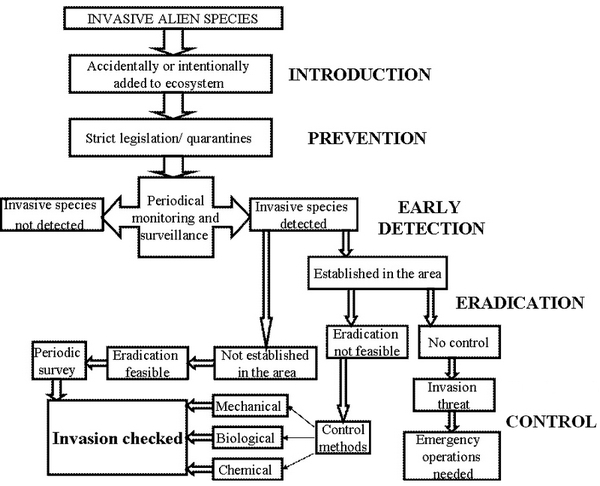|
Invasive species: The
concept, invasion process, and
impact and management of invaders
�By:
Purnima Raizada*
Invasion is considered as the second most
important threat to biodiversity after habitat destruction. Alien species,
which locally become dominant and invade natural communities, are referred
to as invasive species. Further, IUCN also defines alien invasive species,
as a species that becomes established in natural or semi-natural ecosystem
or habitat, is an agent of change and threatens biological diversity.
Invasive species are so much important in the present scenario that, article
8(h) of the Biodiversity Convention asks for measures ��to prevent the
introduction, control or even eradication of those alien species which
threaten ecosystems, habitats or species��. These invaders could be plant,
animal or microbial species. Invasive species are either accidentally
introduced or they are introduced by man to fulfill his needs. After
introduction, they can expand their population and create mono-specific
thickets. In this way these species can affect ecosystem processes,
biodiversity patterns and community structure. Some important invasive
species across the world are
Salvinia molesta,
Eucalyptus species,
Hakea species,
Lantana camara,
Caesalpinia decapetala,
Chromolaena odoratum,
Eichhornia crassipes and
Solanum mauritianum in Africa; Chrysanthemoides
monilifera, S. mauritianum, Brassica tournefortii, Asparagus
densiflorus, L. camara, Ardisia elliptica
and
Berberis thunbergii
in Australia;
Fallopia japonica, Impatiens glandulifera,
Rhododendron ponticum, Gleditsia triacanthos
Crassula helmsii, Acer pseudoplatanus
and
Ailanthus altissima
in
Europe; Centaurea diffuas,
Bromus tectorum, Hydrilla verticillata,
Melaleuca quinquenervia, Mimosa pudica,�
Tamarix spp., Panicum repens,
E. crassipes,
Centaurea solstitialis,
Phragmites australis and
Imperata cylindrica�
in
North American continent. Some invasive species found in Indian
subcontinent, their country of origin, habitats invaded and impact on
ecosystems are presented in� table 1.
Factors conferring invasiveness
Factors which play a key role in the successful establishment and survival
of these species are: unrestrained vegetative spread, escape from biotic
constraints, prolific seed production, highly successful seed dispersal,
germination, and colonization, adaptive morphological and ecological
characters, superior propagule characteristics favoring greater mobility,
and ability to supplant native flora either competing for resources or
exerting allelopathic effects.
Invasion Process
There are three major phases of plant invasion: introduction,
colonization and naturalization. When an ecosystem is disturbed either
by natural processes or due to some anthropogenic factors it provides a kind
of invasion window to the alien propagule. Gradually, it overcomes the
environmental, reproductive and dispersal barriers and expands its
population. Environmental factors like resources availability favoring
establishment of alien propagule are
believed to be the most important at introduction phase because introduced
propagule has to compete with the established flora that is already well
adapted to the site. Figure 1 provides an insight into the invasion process.
Impacts of invaders
Invasive species modify all the major ecosystem processes in the way, which
suits them best. Alteration in litter dynamics is the first and
foremost impact observed in the ecosystem, which an invader invades.
Gradually other ecosystem processes depending on litter dynamics viz.
soil biota, nutrient dynamics and biogeochemical cycles
are also modified. Later, geomorphology and hydrology of the area
are also changed as invasion proceeds. During the course of
establishment these invasive species also interfere with native species
recruitment either by allelopathic suppression or by
competing with seedlings for resources. The invasive species are also known
to alter fire regimes.
Management strategy against invaders
Invasive
species cause degradation of ecosystem. As an invasive species is
established in an ecosystem it interferes with the growth and recruitment of
other native species. Further, once an equilibrium among species has
occurred, it further disturbs homeostasis of ecosystem and weakens it.
Accidental introduction is not easily checked but intentional introduction
of alien species should be done with prior assessment so that they may not
harm the ecological integrity of an ecosystem. For management of these
species basic strategy of prevention, eradication and control should be
adopted as explained in figure. While opting for biological control
methods we should take care that the biological agents may not create a
problem in later years.

Figure: Management
strategy against invasive species.
�
Table 1: Some
important invasive species in India
|
Invading species |
Country of Origin |
Habitats invaded |
Impact on ecosystem |
|
Ageratum conyzoides |
Central and South America |
In wastelands and outskirts |
Fast growth and easily
dispersable seeds help in fast spreading and it also has�
allelopathic inhibition against native species. |
|
Eichhornia.� crassipes |
Brazil |
Ponds and water bodies
having blockages |
Hinders navigation, chokes
water bodies and reduces biodiversity by causing anoxia and
degrades water quality. |
|
Eypatorium odoratum |
Mexico |
Forest roads |
Capable of growing much
faster than native� species and is a problem in plantation
areas. |
|
Eupatorium adenophorum |
America, mainly Mexico |
Warm and humid areas having
early successional communities developed after slash and
burn agriculture |
Reproductive capacity and ecological
adaptive capacity are strong and it grows very fast and causes
allelopathic inhibition |
|
Ipomoea� carnea |
Tropical America |
Wetland having large amount of sand and
clay |
Due to fast growth rate it is replacing
indigenous species and also have negative effects on wetlands
because of semi-aquatic nature. |
|
Lantana� camara
|
Tropical and subtropical
America |
Wastelands and disturbed
forests areas |
High nutrient extraction
efficiency favors its faster growth than natives and supplant
native vegetation. |
|
Mikania micrantha |
Tropical America
|
In jhum cultivated areas |
Prevents forest
regeneration in invaded areas. |
|
Prosopis juliflora |
West Indies and tropical
America |
In open dry places |
It forms almost pure populations wherever
it invades and excludes all native species due to its
allelopathic effects. |
|
Parthenium hysterophorus |
West Indies, central and
south America |
Open wastelands and
cultivated fields |
Its prolific seed
production and fast spreading capability favors its growth; it
also has strong allelopathic effect. |
|
Salvinia molesta |
Southeastern Brazil |
Best in stagnant or slow-flowing water |
Suppresses growth of native
specie in water bodies, forms floating mats. |
|